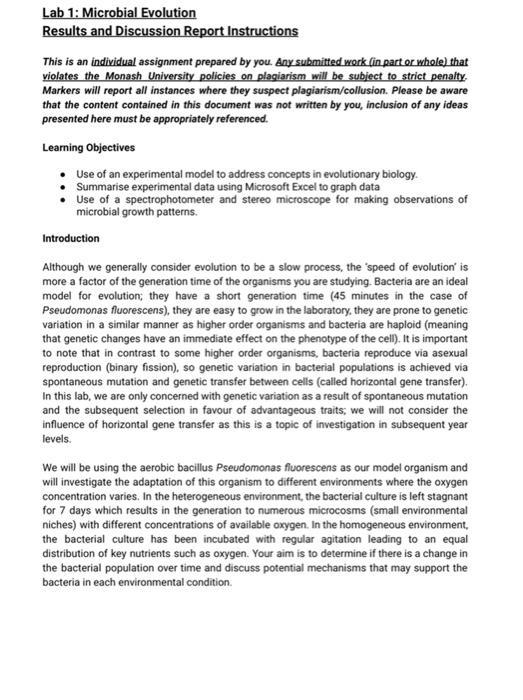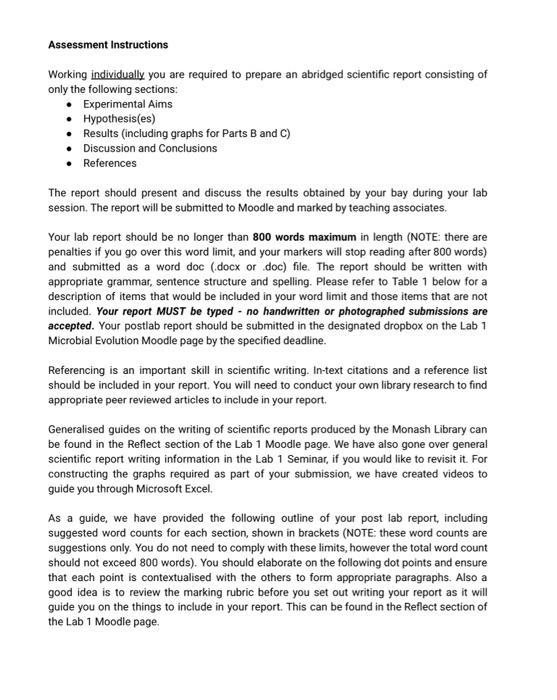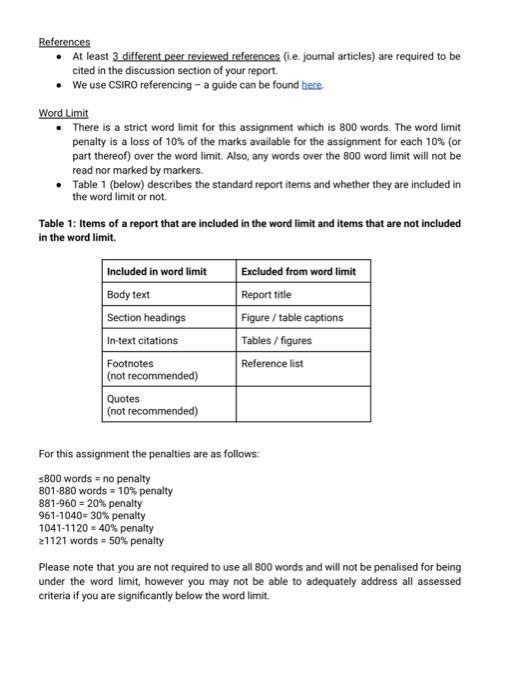Answered step by step
Verified Expert Solution
Question
1 Approved Answer
Lab 1: Microbial Evolution Results and Discussion Report Instructions This is an individual assignment prepared by you. Any submitted work (in part or whole)




Lab 1: Microbial Evolution Results and Discussion Report Instructions This is an individual assignment prepared by you. Any submitted work (in part or whole) that violates the Monash University policies on plagiarism will be subject to strict penalty. Markers will report all instances where they suspect plagiarism/collusion. Please be aware that the content contained in this document was not written by you, inclusion of any ideas presented here must be appropriately referenced. Learning Objectives Use of an experimental model to address concepts in evolutionary biology. Summarise experimental data using Microsoft Excel to graph data Use of a spectrophotometer and stereo microscope for making observations of microbial growth patterns. Introduction Although we generally consider evolution to be a slow process, the 'speed of evolution' is more a factor of the generation time of the organisms you are studying. Bacteria are an ideal model for evolution; they have a short generation time (45 minutes in the case of Pseudomonas fluorescens), they are easy to grow in the laboratory, they are prone to genetic variation in a similar manner as higher order organisms and bacteria are haploid (meaning that genetic changes have an immediate effect on the phenotype of the cell). It is important to note that in contrast to some higher order organisms, bacteria reproduce via asexual reproduction (binary fission), so genetic variation in bacterial populations is achieved via spontaneous mutation and genetic transfer between cells (called horizontal gene transfer). In this lab, we are only concerned with genetic variation as a result of spontaneous mutation and the subsequent selection in favour of advantageous traits; we will not consider the influence of horizontal gene transfer as this is a topic of investigation in subsequent year levels. We will be using the aerobic bacillus Pseudomonas fluorescens as our model organism and will investigate the adaptation of this organism to different environments where the oxygen concentration varies. In the heterogeneous environment, the bacterial culture is left stagnant for 7 days which results in the generation to numerous microcosms (small environmental niches) with different concentrations of available oxygen. In the homogeneous environment, the bacterial culture has been incubated with regular agitation leading to an equal distribution of key nutrients such as oxygen. Your aim is to determine if there is a change in the bacterial population over time and discuss potential mechanisms that may support the bacteria in each environmental condition Assessment Instructions Working individually you are required to prepare an abridged scientific report consisting of only the following sections: Experimental Aims Hypothesis(es) Results (including graphs for Parts B and C) Discussion and Conclusions References The report should present and discuss the results obtained by your bay during your lab session. The report will be submitted to Moodle and marked by teaching associates. Your lab report should be no longer than 800 words maximum in length (NOTE: there are penalties if you go over this word limit, and your markers will stop reading after 800 words) and submitted as a word doc (.docx or doc) file. The report should be written with appropriate grammar, sentence structure and spelling. Please refer to Table 1 below for a description of items that would be included in your word limit and those items that are not included. Your report MUST be typed - no handwritten or photographed submissions are accepted. Your postlab report should be submitted in the designated dropbox on the Lab 1 Microbial Evolution Moodle page by the specified deadline. Referencing is an important skill in scientific writing. In-text citations and a reference list should be included in your report. You will need to conduct your own library research to find appropriate peer reviewed articles to include in your report. Generalised guides on the writing of scientific reports produced by the Monash Library can be found in the Reflect section of the Lab 1 Moodle page. We have also gone over general scientific report writing information in the Lab 1 Seminar, if you would like to revisit it. For constructing the graphs required as part of your submission, we have created videos to guide you through Microsoft Excel. As a guide, we have provided the following outline of your post lab report, including suggested word counts for each section, shown in brackets (NOTE: these word counts are suggestions only. You do not need to comply with these limits, however the total word count should not exceed 800 words). You should elaborate on the following dot points and ensure that each point is contextualised with the others to form appropriate paragraphs. Also a good idea is to review the marking rubric before you set out writing your report as it will guide you on the things to include in your report. This can be found in the Reflect section of the Lab 1 Moodle page. Aims (50 words) Here you will briefly describe the overall aim of the experiment. This is typically a summation of the research question(s) you wish to answer. Hypothesis (~100 words) It is hypothesised that....... Make sure you keep it within the context of the experiment that you are doing in the lab (not linking to the big picture of it all, save what your experimental results would mean for the discussion, when you actually have your results). Remember that you must describe the various conditions of the experiment and what these conditions are trying to achieve. Include a brief justification i.e. predictions contain a what, hypotheses contain a why related to your predictions. Results including graph(s)/chart(s) (~200 words) Include a short paragraph highlighting the important observations made from the figure. The idea here is to draw the attention of your reader to the take home points that you will further elaborate upon in the discussion section. You will be required to graphically present the results collected in parts B and C of your experiment. Ensure that you refer to the figure containing the data when highlighting key points. There should be no further elaboration of the results in this section - don't talk about what the results mean. This is the job of your discussion section. Discussion (~500 words) Relate your hypothesis to the results that you obtained. Was your hypothesis supported? Why or why not? It is important to not re-state all your results (you may mention the major trends) as you have already guided your reader through the results (remember, you have a word limit). Here your focus should be on the explanation of these results and how they justify (or not) your hypothesis. Based on your results, what are the main conclusions that you can draw through comparisons of your conditions? What might the reason be for this? Typically scientists will often relate their findings to those already published in the scientific literature, you will do the same. We encourage you to conduct your own literature research for this report. Ensure that you finish your discussion with a general conclusive paragraph. What is the "take-away" message that you want your readers to have? Did your results support the hypothesis? If not, then why not? Avoid turning your entire discussion into an analysis of experimental errors. The maximum you would want to spend on this is 1-2 sentences, and usually only if you have a strange result you need to discuss. Instead, it is perfectly valid to discuss why the experimental method may not be ideal, or could be improved. References At least 3 different peer reviewed references (.e. journal articles) are required to be cited in the discussion section of your report. We use CSIRO referencing - a guide can be found here. Word Limit There is a strict word limit for this assignment which is 800 words. The word limit penalty is a loss of 10% of the marks available for the assignment for each 10% (or part thereof) over the word limit. Also, any words over the 800 word limit will not be read nor marked by markers. Table 1 (below) describes the standard report items and whether they are included in the word limit or not. Table 1: Items of a report that are included in the word limit and items that are not included in the word limit. Included in word limit Body text Section headings In-text citations Footnotes (not recommended) Quotes (not recommended) Excluded from word limit Report title Figure / table captions Tables/figures 1041-1120 = 40% penalty 21121 words = 50% penalty Reference list For this assignment the penalties are as follows: $800 words no penalty 801-880 words = 10% penalty 881-960 = 20% penalty 961-1040-30% penalty Please note that you are not required to use all 800 words and will not be penalised for being under the word limit, however you may not be able to adequately address all assessed criteria if you are significantly below the word limit.
Step by Step Solution
★★★★★
3.49 Rating (156 Votes )
There are 3 Steps involved in it
Step: 1
Lab 1 Microbial Evolution Results and Discussion Report Aim To analyse the behaviour of the bacteria Pseudomonas fluorescens over time under differentenvironmental conditions with varying oxygen conce...
Get Instant Access to Expert-Tailored Solutions
See step-by-step solutions with expert insights and AI powered tools for academic success
Step: 2

Step: 3

Ace Your Homework with AI
Get the answers you need in no time with our AI-driven, step-by-step assistance
Get Started


